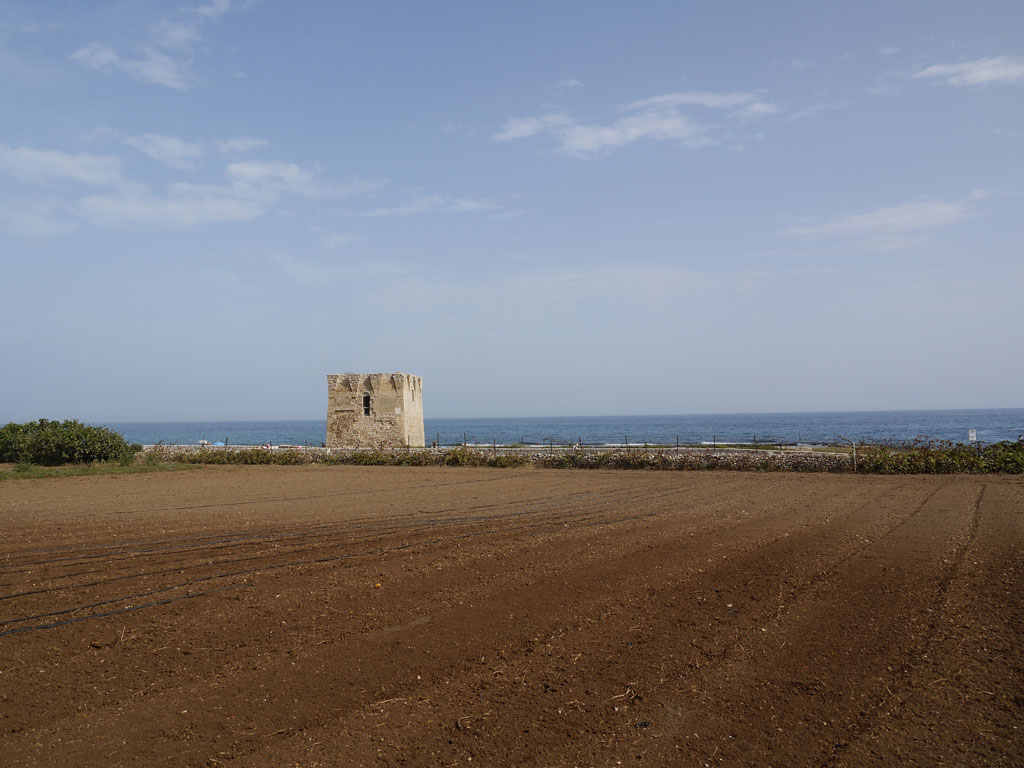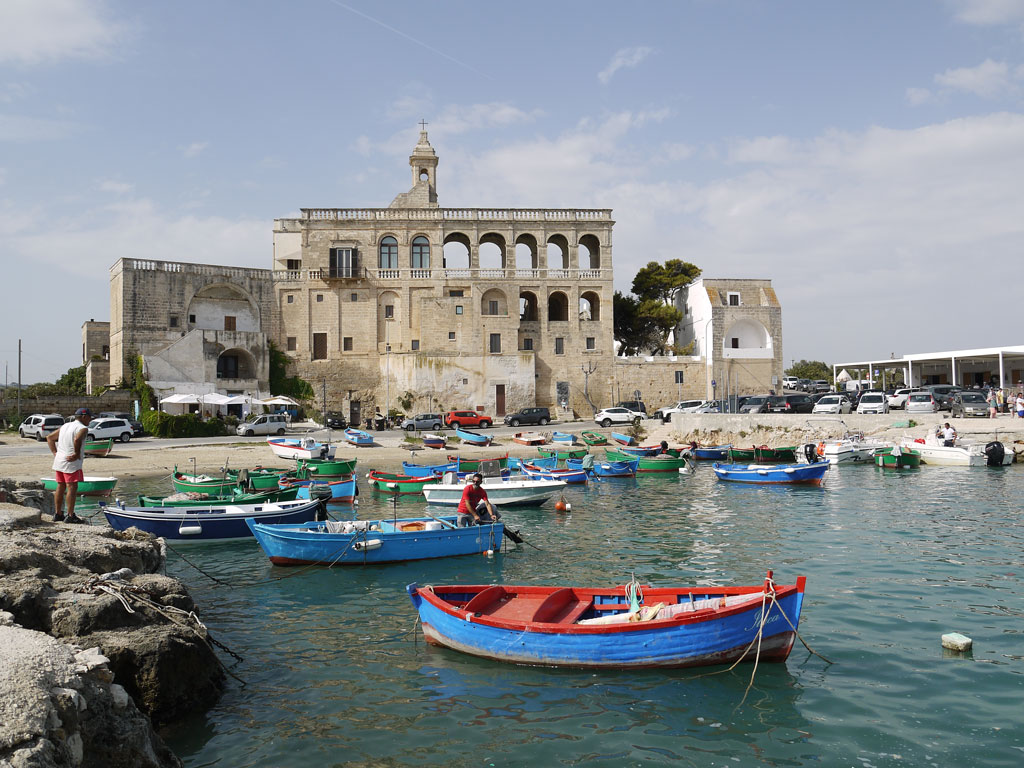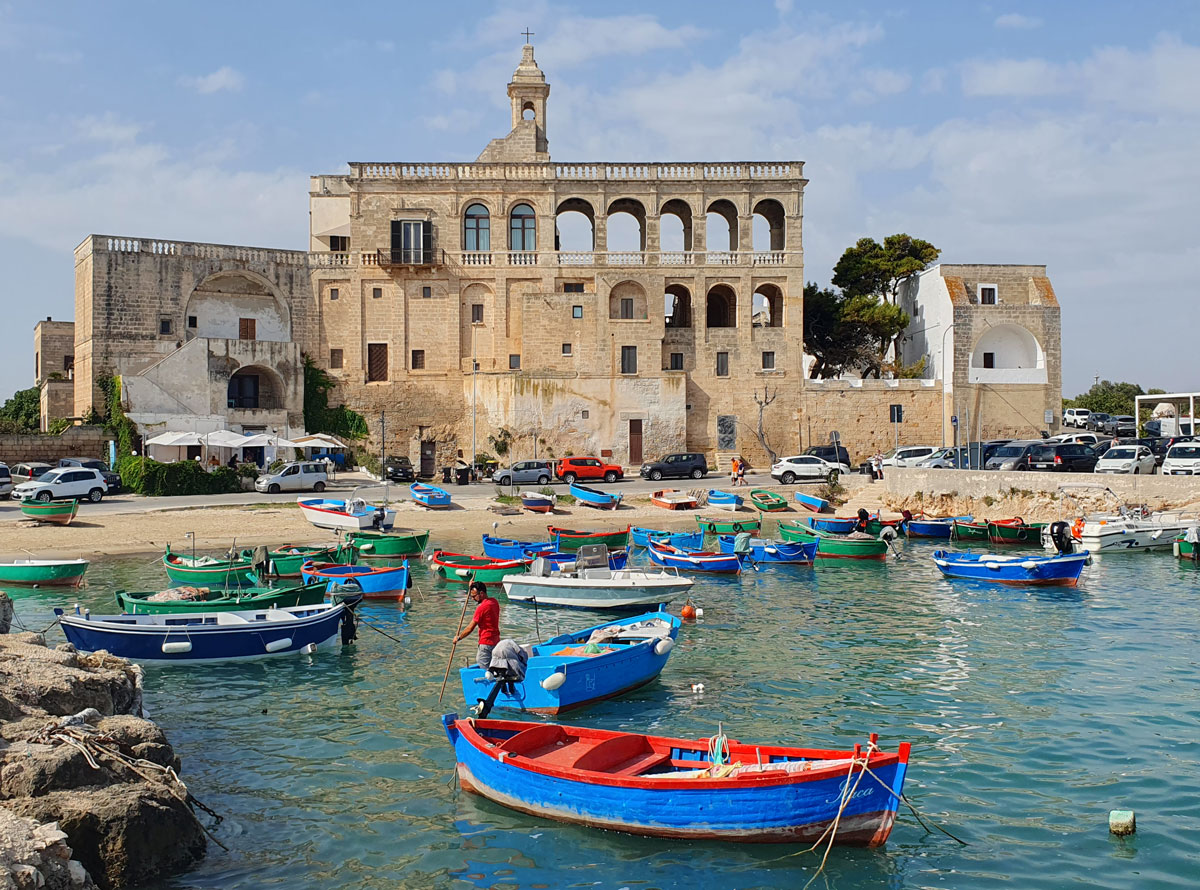The Abbey of San Vito (Abbazia di San Vito or more fully the Abbazia di San Vito Martire) is an enormously picturesque former monastery located by the sea in Puglia. A couple of miles along the coast north-west from tourist hotspot Polignano a Mare, the abbey and tiny fishing village alongside makes a good excursion from Polignano. Although the abbey is not open to the public, visitors can admire and photograph its exterior – a classic Puglia postcard view. Boat trips along the Polignano coastline embark at the pretty little port here, and you’ll also find a little beach and idyllic bathing spots.
Note that this hamlet of San Vito is in a different part of Puglia to the town of San Vito dei Normanni. It’s generally indicated as the Abbazia di San Vito on maps.
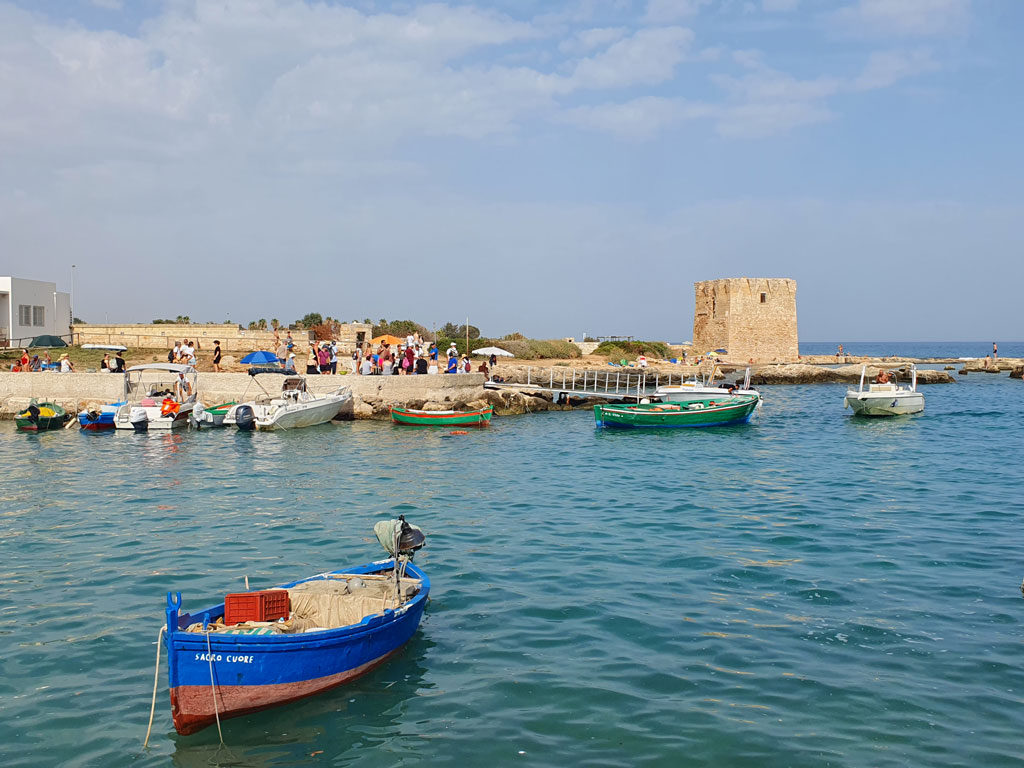
About the Abbey and San Vito
San Vito Martire (St Vitus the Martyr) is the patron saint of Polignano a Mare, and his feast days (14th-16th June) are celebrated with a sea procession bringing the saint’s relics from the abbey church to Polignano for religious celebrations, including being carried through the streets of the town.
There is a story behind the abbey’s unusual waterside location. The tale of the church’s founding relates that a wealthy noblewoman, some say a princess, called Fiorenza or Florenza, was saved from drowning during a storm by a vision of San Vito. After the saint had also healed her sick brother, she sailed along the coast of Italy looking for a ‘coastal location’, as San Vito’s apparition had requested, to build a church in honour of the saint and to house his relics. She came to this little port outside Polignano and built here.
The abbey dates to the 9th century but has been altered many times, with particularly significant alterations in the 16th century. The original church was incorporated into a Benedictine monastery, which then passed through the hands of various religious orders. Later handed to the State, it was sold in 1866 to a noble family, the marchesi La Greca, who still own the building, although not its church.
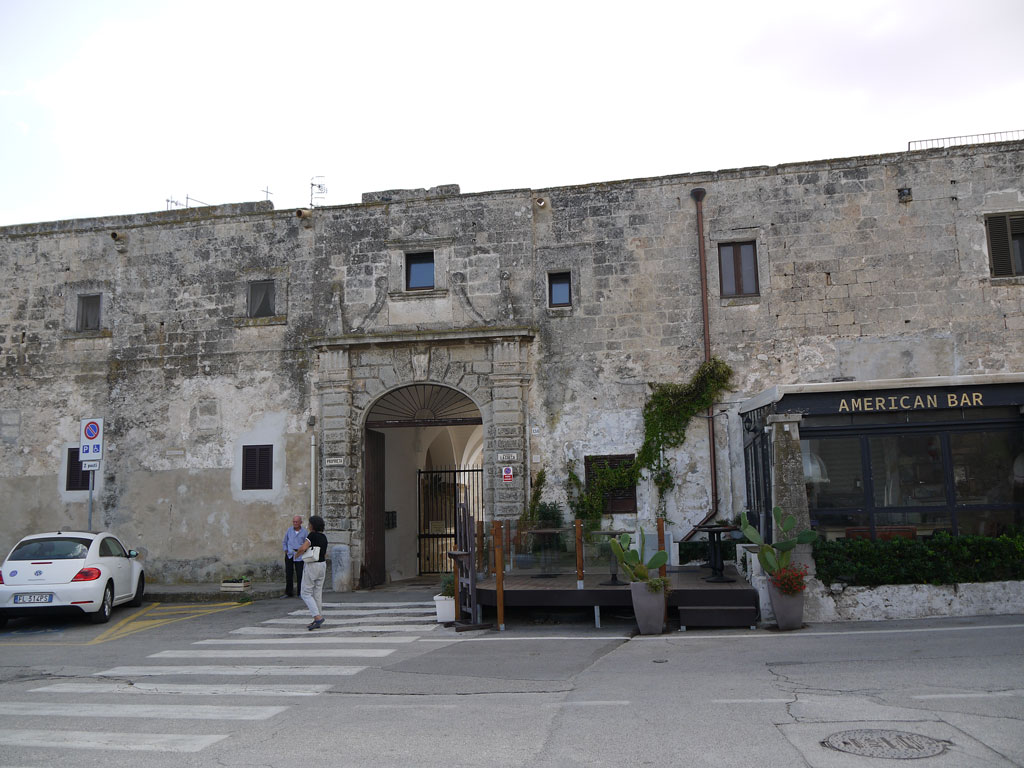
The abbey building is not visitable, though you can admire the exterior and maybe peer through the gate to the courtyard of the complex. On Sundays the church opens for mass.
Here’s a short video clip of the abbey’s courtyard: https://www.facebook.com/watch/?v=642927963878238 and another showing a living Nativity scene inside: https://www.youtube.com/watch?v=g_1PBrKaC7E.
I haven’t been able to find a great deal of detail about the abbey’s history, but a version of the story of Fiorenza’s nautical quest suggests there may have been a community of Basilian (Greek Catholic) monks living in caves and crypts in the rocks locally before the arrival of the saint’s relics. The church is built over the remains of a Roman tower. I found this interesting, as I was curious about some features down at the sea’s edge …
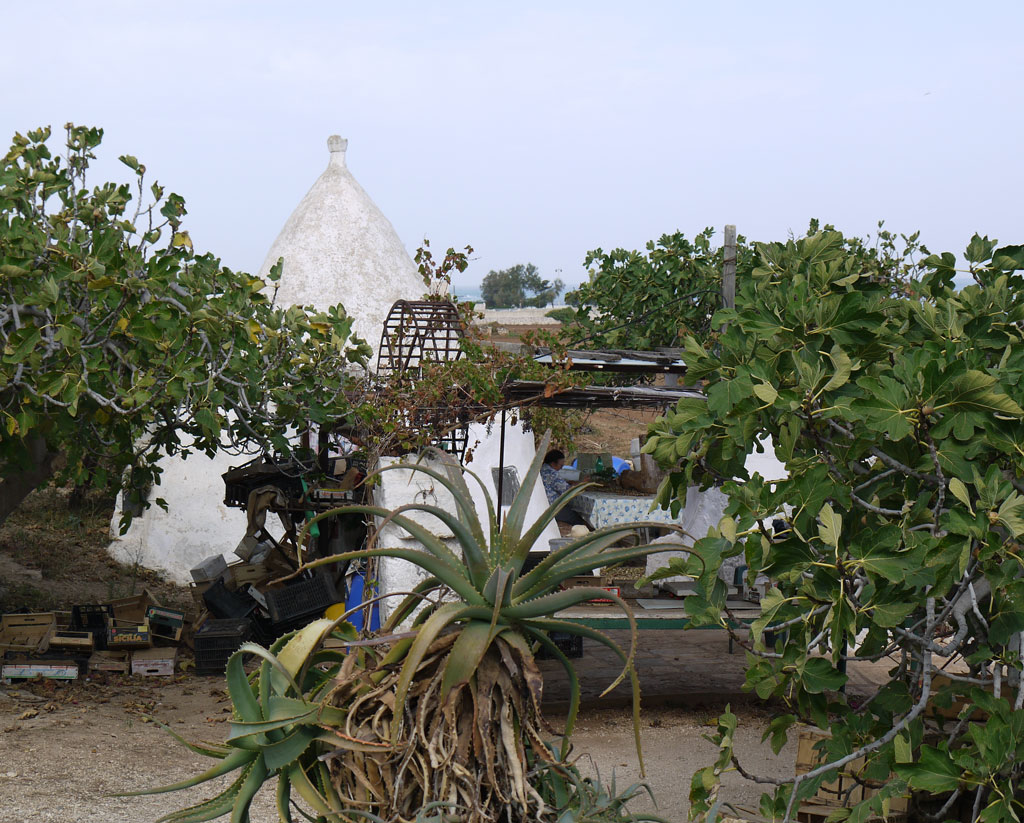
This is an agricultural area as well as a fishing village. Just off the short stretch of road curving up around the corner of the abbey are some fields and a trullo-type rural building among fig trees, where I saw harvested crops being prepared. Outside the abbey gates I passed a man waiting for a lift with a crate of gleaming purple aubergines.
Among the products grown in the fields around San Vito are the carota di Polignano, or carota di San Vito, the Slow Food-listed Polignano carrot with colours ranging from yellow to purple and a flavour that owes its qualities to the local land, including the sandy salinity of the fields.
A less unusual feature of the shoreline at San Vito is a 16th-century watch-tower, the Torre di San Vito. This can be reached by following a path leading from the side of a waterfront bar just below the abbey.
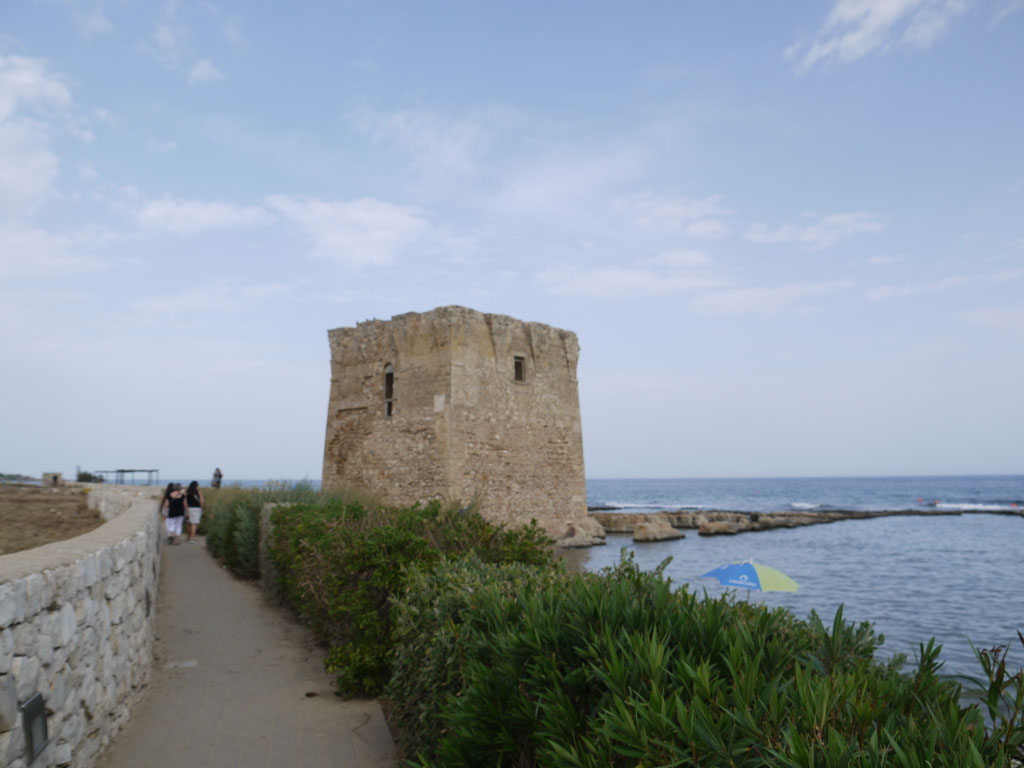
Beach life
Around and beyond the watch-tower are popular spots for sunbathing and swimming. A small beach of rough sand and pebbles extends along a sea wall beyond the tower, and there are expanses of rock to sit or lie on, too.
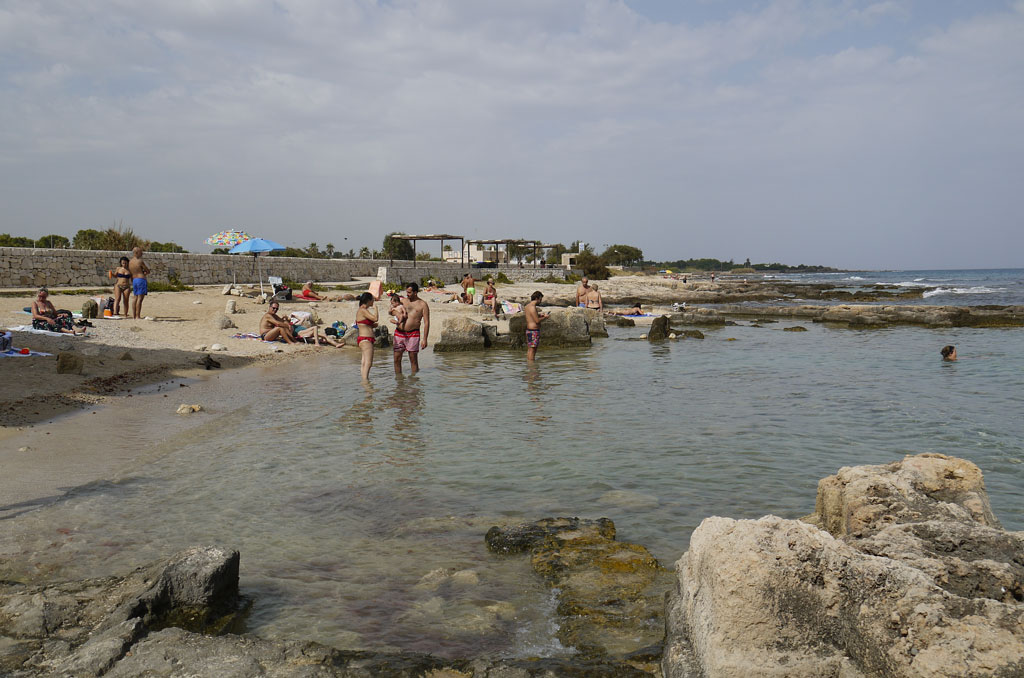
On the seaward side and around the base of the watch-tower are extensive areas of rock which have been cut to form low geometric walls and divisions. I haven’t found any full explanation of these; they reminded me initially of fishponds I’ve seen at the sea’s edge where ancient Romans would rear fish or eels to eat. Without having unearthed any reference to these curious pools being that ancient, I wondered if they were for a similar purpose but associated with one of the communities of monks who ran the abbey over the centuries. I’ve seen them described as ‘natural pools’ but also as the remains of fortifications. Maybe they relate to the watch-tower and local sea defences, were refuges for boats (though they seem too shallow) or are simply recent and intended for recreational sea bathing.
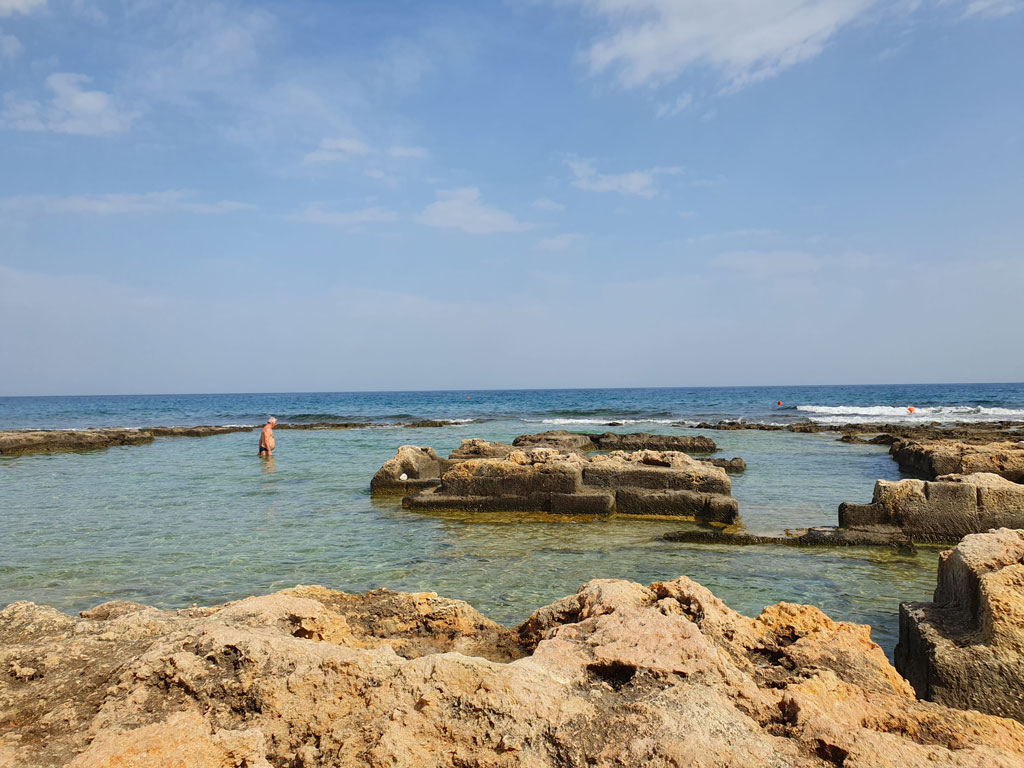
Whatever their origin, these rock pools and rock-cut walls create a shallow sheltered environment that is great for paddling, basking in the sun-warmed water or wading out while enjoying the calm shelter and safe depth of the sea. As a paddler, not a swimmer, I found this delightful. When I found a ‘seat’ cut into the rock where I could sit and dangle my feet into the seawater I was in bliss, and decided this was one of my favourite seaside spots anywhere in Italy. After the hot dusty walk from Polignano, cooling my feet off in the water was wonderfully reviving.
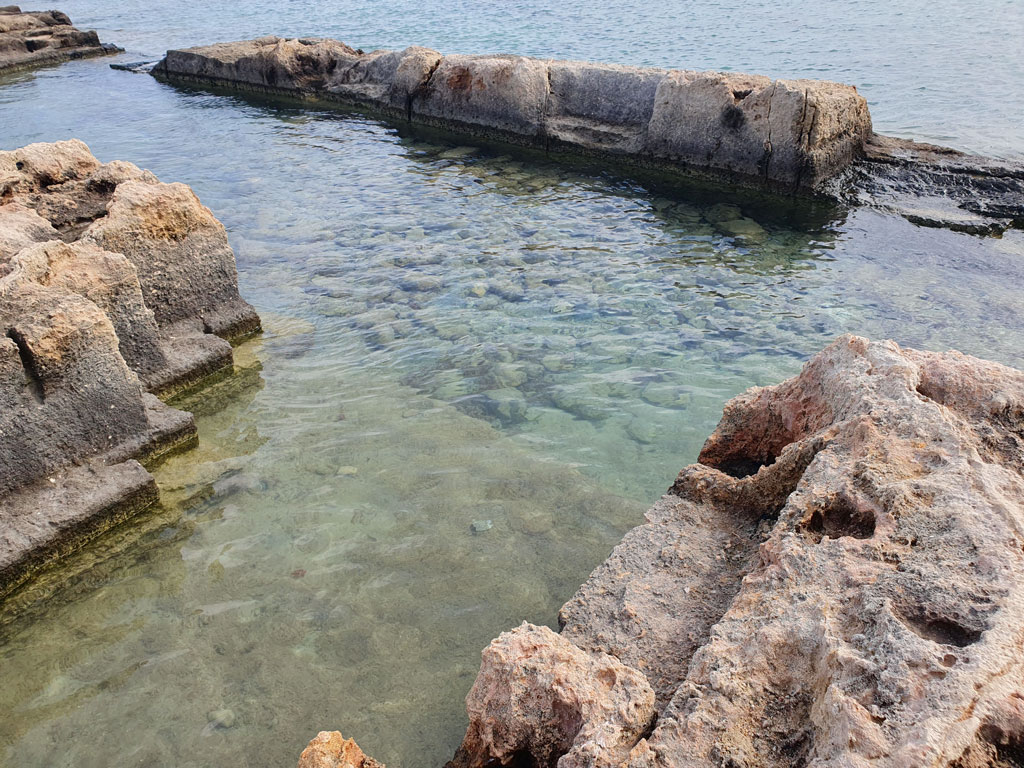
On a practical note, there are several restaurants on the opposite side of the little port (porticciolo) to the watch-tower, as well as the port-side bar. When I visited, cars were parked in lay-bys and along the sides of the road. There were some portaloos (which I didn’t investigate) opposite the abbey entrance, and the bar by the port had a queue for its toilet for paying customers.
Boat trips depart from the rocks beyond the bar, and small colourful fishing boats bob in the water in front of the abbey’s splendid façade of many arches. As I was taking photos, a fisherman in swimming trunks brought his boat in, and then stood gutting fish on a step at the water’s edge. Despite the tourism, this is a place with authentic rough-and-ready feel.
A path continued along the shore away from the watch-tower, but unfortunately I didn’t have time to explore further to see more views or swimming spots.
With its obvious cinematographic appeal, this setting has been featured in a number of films. You can spot San Vito in the Netflix movie Jumping from High Places, where the protagonist works at one of the seafront restaurants (read my guide to Jumping from High Places filming locations), and in the 2013 Italian/German film La mia bella famiglia italiana.
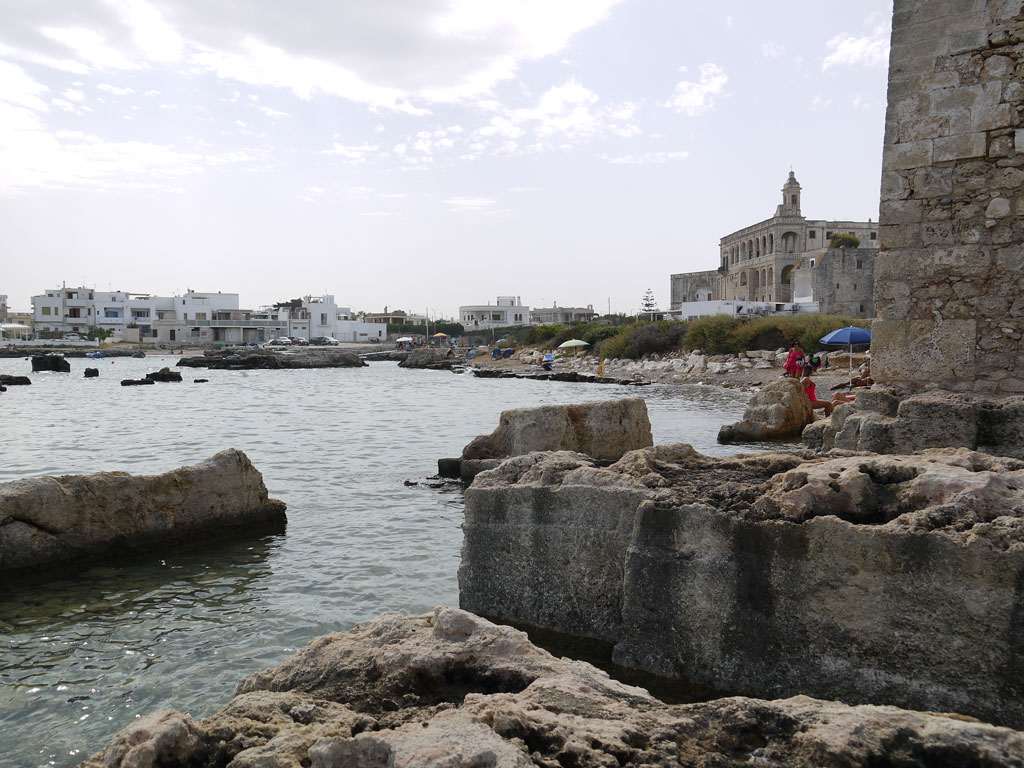
Getting to the Abbey of San Vito from Polignano a Mare (with or without a car)
It is quite straightforward to reach the Abbazia di San Vito without a car, as long as you are either energetic or prepared to pay for a taxi. I travelled on foot on the outward journey and caught one of the jolly little local three-wheeler taxis back to Polignano for the return trip. Another option would be to cycle, following the same route described in my walking directions below (for bike hire in Polignano try https://www.polignanomadeinlove.com/).
In the height of summer, there may hopefully be a shuttle bus service (bus navetta) running along the coast between Polignano and San Vito to serve the local beaches – recently this has operated hourly every day throughout July and August. Ask at the local tourist information office if this will be active during your stay.
If you do have a car, it’s an easy drive of a few minutes along Via San Vito out of town, taking a right-hand turn either before or after San Vito – the access road serving the coastal hamlet loops around past the abbey then returns to rejoin the main road. Although drivers won’t need my walking directions below, you’ll find some descriptions of the route, sights and bathing spots along the way which might be of interest.
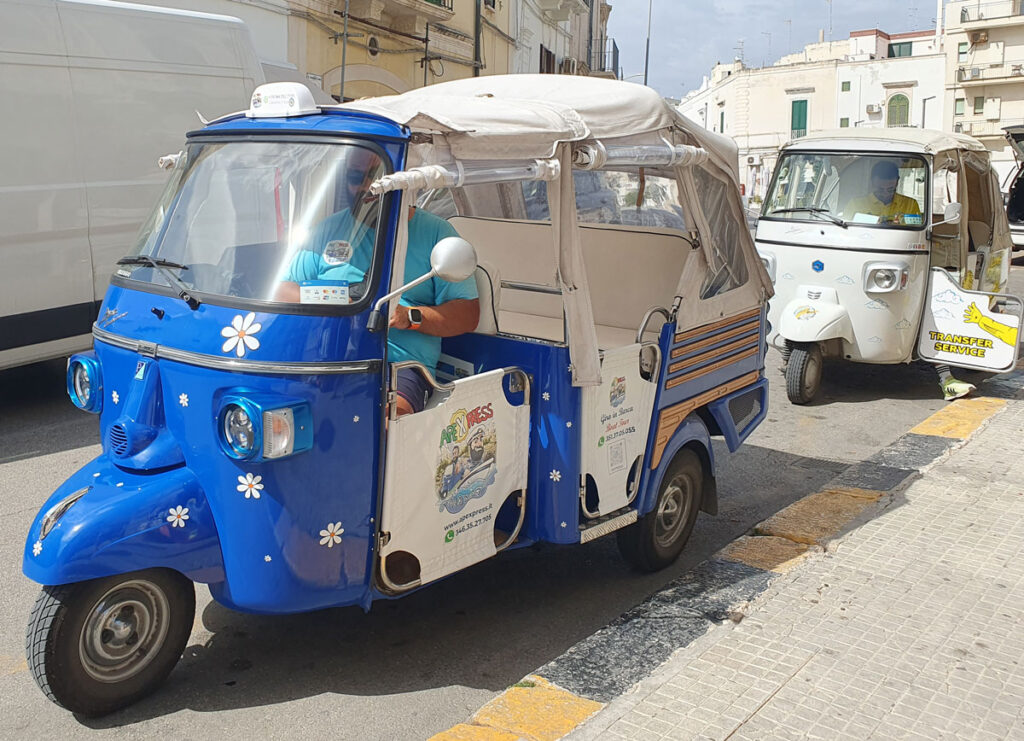
Walking to San Vito from Polignano
Google Maps is of course very helpful, but I started my trip with a visit to the tourist information point in Polignano, which is conveniently located on the route to the town centre from the railway station. I picked up a map and got some practical advice and details of the walking route; not essential but not a bad idea.
The one-way walk from Polignano took me about 45 minutes, maybe a little more. It was a hot September day, about 30 degrees Celsius, and although mildly interesting, the trek was also hot and tiring; I took my time and didn’t rush. Make sure you have some drinking water (there’s a tap for refilling along the route), and if it’s sunny, wear a hat and sun lotion; there’s no real shade. I’d also suggest getting the number of a local taxi in case you need it later (ask at the tourist office or take a business card from one of the drivers of the three-wheelers you’ll see around town). The walk was mostly on road surfaces, so you don’t need particularly tough shoes, but make sure they’re comfortable.
As both Polignano and San Vito are on the coast, and roads hug the shore for most of the way, the route is relatively straightforward. From the centre of Polignano a Mare, cross the bridge past the Lama Monachile bay heading away from the town centre. Then continue straight along the main road, Via San Vito.
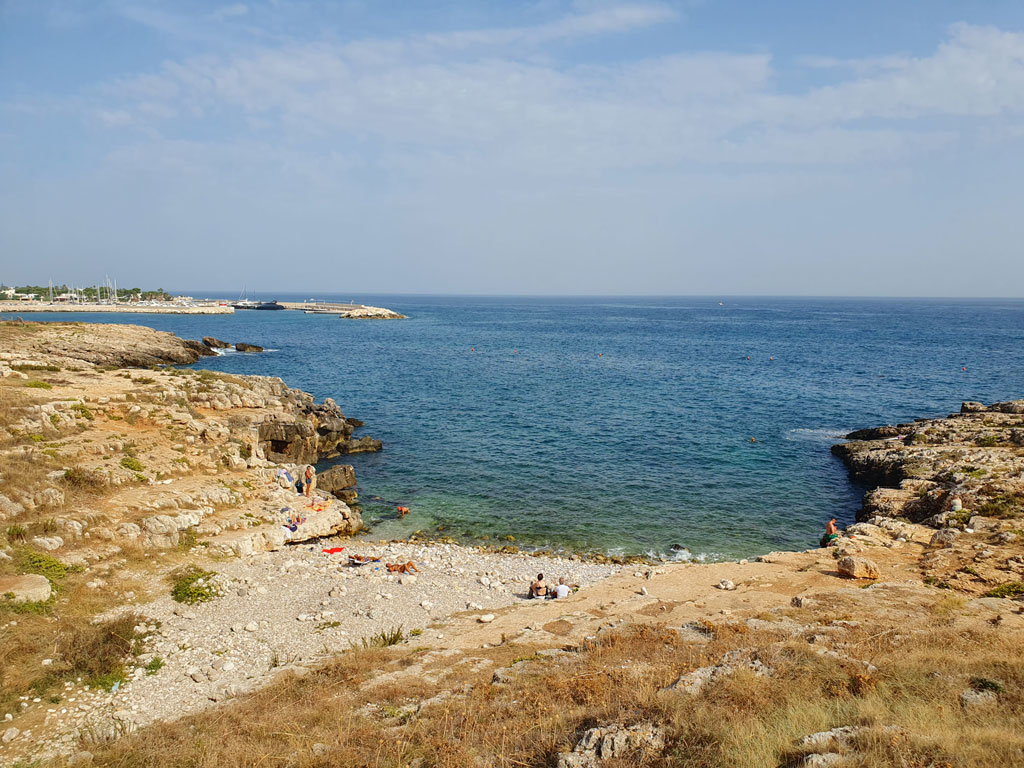
For the first part of the walk out to San Vito I walked in a cycle lane – unused by cyclists during the whole time I was walking. Luckily the roads weren’t busy either, though I saw a number of the little ape taxis pass by carrying tourists.
Along the coast there were some parking areas (one with camper vans) and rocky coves, one or two with people sunbathing. On the other side of the road were stone walls, and once the buildings ran out, I could see fields inland. In the early stages of the walk the abbey was visible, shimmering in the distance and looking vast and monumental. It may have looked a long way off, but it was still an encouraging sight as I began my hike.
Directions: The coastal road heads straight along the shore north-west from the town, with the sea on your right. The cycle lane, separated from traffic, runs as far as a junction where a small lane heads down towards the sea (the cycle lane ends here). At this corner there’s a welcome spot to take a break, with benches and a water tap.
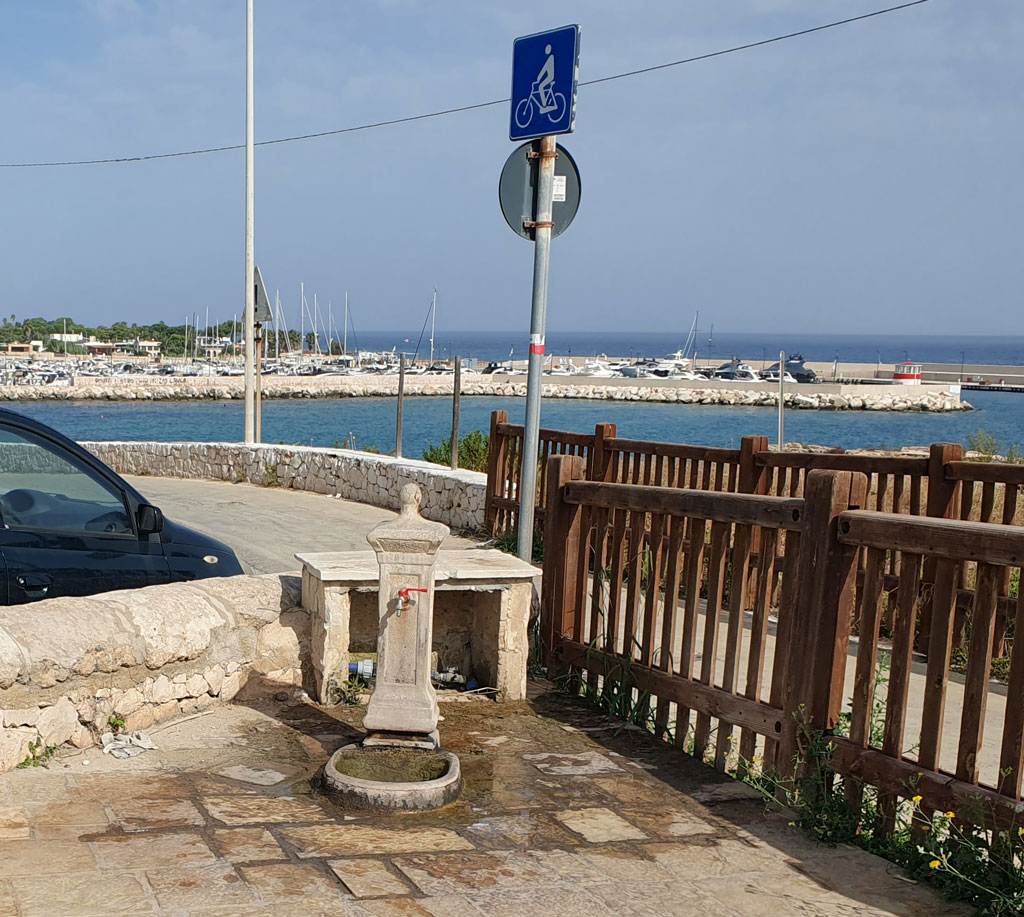
To skip a section of main road without a pavement or cycle lane, you can take the option of following the quieter lane on the right towards the sea. This heads to a leisure marina, Cala Ponte. Unluckily at the time of writing there wasn’t public access across the back of the marina to the San Vito access road beyond (if this has changed by the time of your visit, cutting through here will be the best route). So you need to head left/upwards again, through a car parking area, to rejoin the main road.
At this point there’s an unavoidable short stretch of road without pavement, so be very careful. (I’d optimistically like to think that cycle and pedestrian lanes might have been extended by the time some of my future readers head along this way).
After a very short distance you turn right down the smaller access road to San Vito. Much of this road doesn’t have a pavement either, but it is less fast and reasonably quiet, used by a mix of residential traffic and visitors looking for parking spaces before heading to beaches. The sight of pedestrians along this stretch shouldn’t be too unexpected for drivers.
There weren’t many views on this part of the walk, as the sea is mostly invisible from the road, separated from it by buildings and land. I liked some slightly unusual seaside architecture stuck here in unlikely surroundings; a row of dated, white holiday maisonette apartments. There was quite an appealing cove where the road reached the sea a short distance before the abbey, Porto Contessa, which seemed a nice place to swim and enjoy the sea.
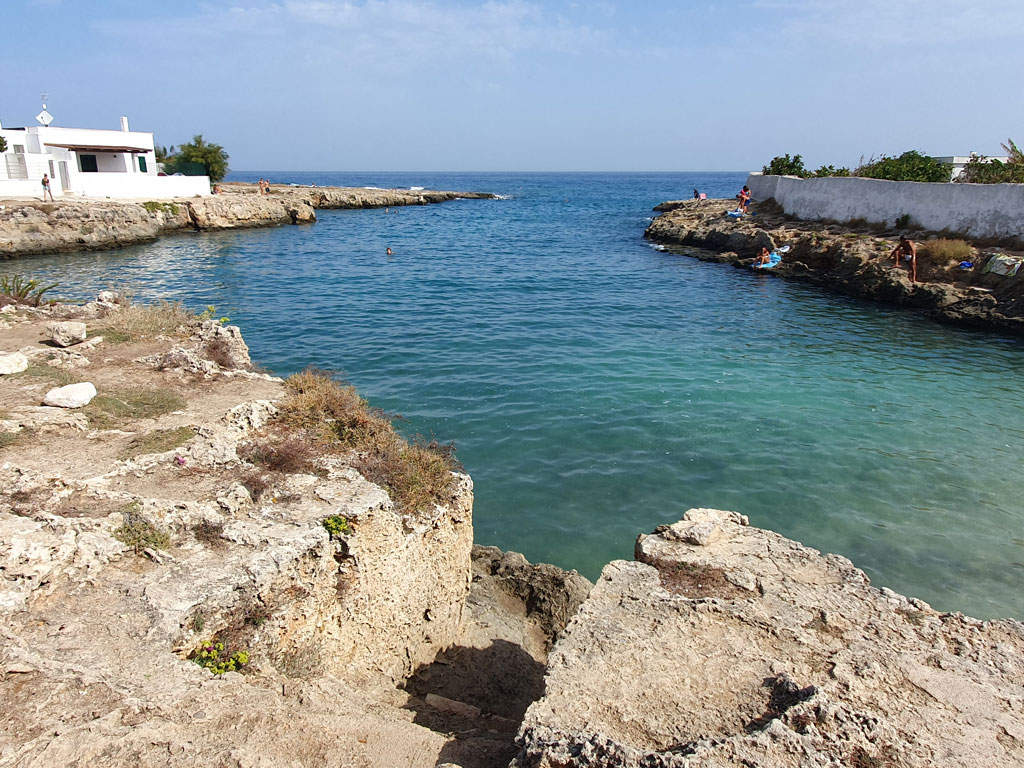
Although I love walking, I noted in my travel journal that the walk was not particularly enjoyable in the heat, although it was rewarding and interesting. Having seen any views there were on the outward journey, I was not very enthusiastic about walking back. I’d seen a number of ape taxis dropping their passengers off by the seafront bar in San Vito, so when I was ready to return, I just loitered here to intercept one when the driver dropped off passengers. I didn’t have a long wait, or I’d have asked at the bar for a taxi number. My driver, Giuseppe, charged €10 for the trip; this seemed fairly standard and reasonable, though of course prices may have risen by the time you read this.
I’d suggest that unless you are on a tight budget or actively enjoy exercise (both applied to me), you consider taking a taxi both ways. My compromise of walking one way and catching a taxi the other was a good choice for me, though.
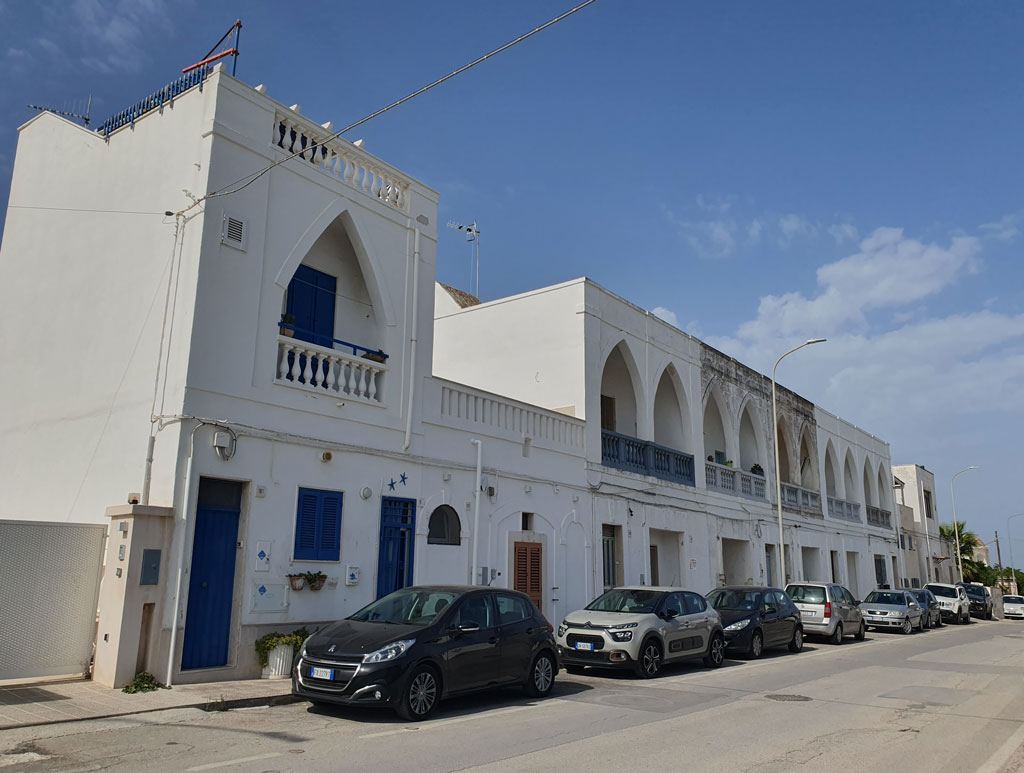
Why visit the Abbey of San Vito?
The Abbazia di San Vito offers several picture-postcard views: the abbey itself in its shabby-picturesque majesty, the colourful fishing boats moored in the little port, and the coastal watchtower. If you’re keen on photography and the picturesque, it’s a must-see if you are in the area.
The seafront village offers the chance to sit with a meal or drink near the water’s edge and enjoy the atmosphere, so different to nearby Polignano a Mare. This is also the place to come if you want to take a boat trip along the shore to see the cliffs and grottoes of Polignano.
The rocky bathing spots and little beach are a great attraction to sun and sea lovers. Especially for those with children or who like to paddle safely in warm shallow waters. Although it can undoubtedly get busy, I found the shoreline here was much quieter and more mellow in atmosphere than the packed Lama Monachile beach in Polignano.
The atmosphere and vibe is a bit makeshift and ramshackle, and while that will be the charm of it for some, it’s not going to appeal to everyone. There will be those for whom this is an unnecessary diversion in an area with lots of other attractions. For many, though, this is Puglia at its unpretentious best. Hopefully this page will help you decide which applies to you.
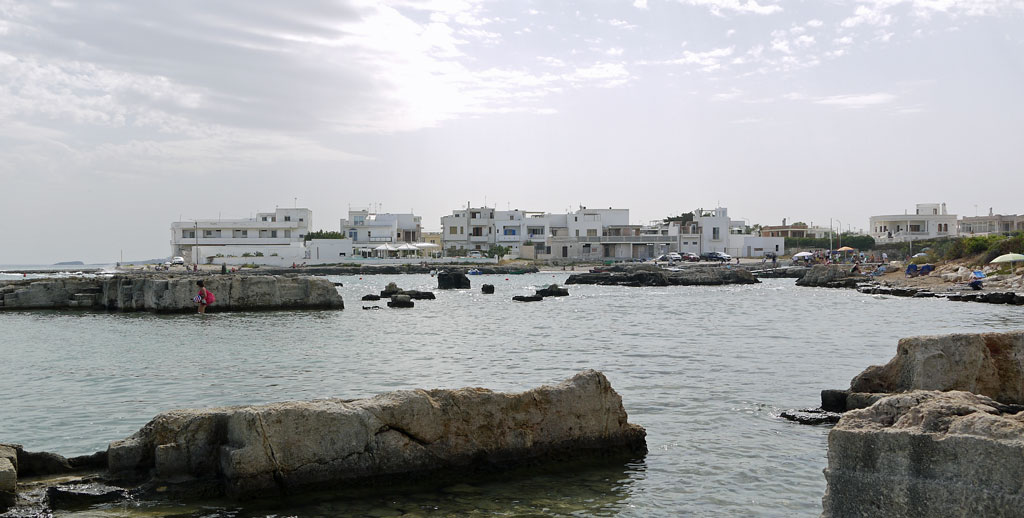
Staying around the Abbey of San Vito
The coast around the Abbey of San Vito would be an atmospheric and appealing place to stay if you’re looking for sea air and an out-of-town location. There are also some good out-of-town options up by the main road leading out of Polignano, which may suit travellers touring with a car.
- Find accommodation around the Abbey of San Vito – a full search, including villas
- Musae al Mare – a seaside idyll B&B where suites have private terraces and hot tubs
- Vilu Suite Mare – comfortable modern apartments, some with sea views
